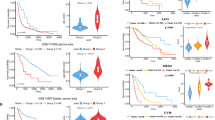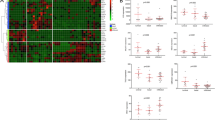Abstract
Glycolysis-targeted cancer therapy based on long non-coding RNAs (lncRNAs), owing to its high specificity and less toxicity, is at the preclinical stages. Our study aimed to examine the roles of the core glycolysis-associated lncRNAs in bladder cancer (BC). Glycolysis scores of BC were computed by single-sample gene set enrichment analysis (ssGSEA). Glycolysis-associated lncRNAs were screened by Pearson’s correlation analysis. Unsupervised consensus clustering using ConsensusClusterPlus assessed the glycolysis-associated lncRNAs for the identification of molecular subtypes of BC. The Kaplan–Meier survival analysis, genomic mutations, and tumor microenvironment (TME) analysis were used to compare the characteristics of different subtypes. Key glycolysis-associated lncRNAs were screened by first-order partial correlation and univariate Cox proportional-hazards model analyses; finally, the lncRNA signature was constructed. Four glycolysis-associated lncRNA-regulated subtypes having differential overall survival (OS), clinical features, genomic mutation profiles, and TME profiles along with nuclear immunotherapeutic responses were identified. Nine lncRNAs localized in the nucleus were identified and transcription factors (TFs) significantly negatively associated with these were found to be enriched in multiple oncogenic signaling pathways. Among them, three lncRNAs (AC093673.5, AC034220.3, and RP11-250B2.3) exerted the most profound effects on glycolysis and constituted the lncRNA signature, which could substantially distinguish the risk levels among different BC patients. Four glycolysis-associated lncRNA-regulated subtypes were identified in this study, reflective of the biological characteristics and heterogeneity of BC. Three key glycolysis-associated lncRNA constituting a signature could predict the risk levels in BC, provide a reference for stratification, and be used as prognostic markers for BC diagnosis and treatment.







Similar content being viewed by others
References
Abdel-Wahab AF, Mahmoud W, Al-Harizy RM (2019) Targeting glucose metabolism to suppress cancer progression: prospective of anti-glycolytic cancer therapy. Pharmacol Res 150:104511. https://doi.org/10.1016/j.phrs.2019.104511
Abdollahzadeh R, Daraei A, Mansoori Y, Sepahvand M, Amoli MM, Tavakkoly-Bazzaz J (2019) Competing endogenous RNA (ceRNA) cross talk and language in ceRNA regulatory networks: a new look at hallmarks of breast cancer. J Cell Physiol 234(7):10080–10100. https://doi.org/10.1002/jcp.27941
Alifrangis C, McGovern U, Freeman A, Powles T, Linch M (2019) Molecular and histopathology directed therapy for advanced bladder cancer. Nat Rev Urol 16(8):465–483. https://doi.org/10.1038/s41585-019-0208-0
Chakraborty H, Hossain A (2018) R package to estimate intracluster correlation coefficient with confidence interval for binary data. Comput Methods Programs Biomed 155:85–92. https://doi.org/10.1016/j.cmpb.2017.10.023
Choi W, Ochoa A, McConkey DJ, Aine M, Hoglund M, Kim WY, Real FX, Kiltie AE, Milsom I, Dyrskjot L, Lerner SP (2017) Genetic alterations in the molecular subtypes of bladder cancer: illustration in the Cancer Genome Atlas Dataset. Eur Urol 72(3):354–365. https://doi.org/10.1016/j.eururo.2017.03.010
Davoli T, Uno H, Wooten EC, Elledge SJ (2017) Tumor aneuploidy correlates with markers of immune evasion and with reduced response to immunotherapy. Science 355 (6322). https://doi.org/10.1126/science.aaf8399
Ganapathy-Kanniappan S, Geschwind JF (2013) Tumor glycolysis as a target for cancer therapy: progress and prospects. Mol Cancer 12:152. https://doi.org/10.1186/1476-4598-12-152
Hänzelmann S, Castelo R, Guinney J (2013) GSVA: gene set variation analysis for microarray and RNA-seq data. BMC Bioinformatics 14:7. https://doi.org/10.1186/1471-2105-14-7
Hu M, Fu Q, Jing C, Zhang X, Qin T, Pan Y (2020) LncRNA HOTAIR knockdown inhibits glycolysis by regulating miR-130a-3p/HIF1A in hepatocellular carcinoma under hypoxia. Biomed Pharmacother 125:109703. https://doi.org/10.1016/j.biopha.2019.109703
Hua Q, Mi B, Xu F, Wen J, Zhao L, Liu J, Huang G (2020) Hypoxia-induced lncRNA-AC020978 promotes proliferation and glycolytic metabolism of non-small cell lung cancer by regulating PKM2/HIF-1alpha axis. Theranostics 10(11):4762–4778. https://doi.org/10.7150/thno.43839
Huang Y, Guo Q, Ding XP, Wang X (2020) Mechanism of long noncoding RNAs as transcriptional regulators in cancer. RNA Biol 17(11):1680–1692. https://doi.org/10.1080/15476286.2019.1710405
Huang P, Zhu S, Liang X, Zhang Q, Luo X, Liu C, Song L (2021) Regulatory mechanisms of LncRNAs in cancer glycolysis: facts and perspectives. Cancer Manag Res 13:5317–5336. https://doi.org/10.2147/CMAR.S314502
Jiang P, Gu S, Pan D, Fu J, Sahu A, Hu X, Li Z, Traugh N, Bu X, Li B, Liu J, Freeman GJ, Brown MA, Wucherpfennig KW, Liu XS (2018) Signatures of T cell dysfunction and exclusion predict cancer immunotherapy response. Nat Med 24(10):1550–1558. https://doi.org/10.1038/s41591-018-0136-1
Kamat AM, Hahn NM, Efstathiou JA, Lerner SP, Malmstrom PU, Choi W, Guo CC, Lotan Y, Kassouf W (2016) Bladder cancer. Lancet 388(10061):2796–2810. https://doi.org/10.1016/S0140-6736(16)30512-8
Kim J, DeBerardinis RJ (2019) Mechanisms and implications of metabolic heterogeneity in cancer. Cell Metab 30(3):434–446. https://doi.org/10.1016/j.cmet.2019.08.013
Kong X, Duan Y, Sang Y, Li Y, Zhang H, Liang Y, Liu Y, Zhang N, Yang Q (2019) LncRNA-CDC6 promotes breast cancer progression and function as ceRNA to target CDC6 by sponging microRNA-215. J Cell Physiol 234(6):9105–9117. https://doi.org/10.1002/jcp.27587
Li J, Eu JQ, Kong LR, Wang L, Lim YC, Goh BC, Wong ALA (2020) Targeting metabolism in cancer cells and the tumour microenvironment for cancer therapy. Molecules 25(20). https://doi.org/10.3390/molecules25204831
Liberzon A, Birger C, Thorvaldsdottir H, Ghandi M, Mesirov JP, Tamayo P (2015) The Molecular Signatures Database (MSigDB) hallmark gene set collection. Cell Syst 1(6):417–425. https://doi.org/10.1016/j.cels.2015.12.004
Lin X, Feng D, Li P, Lv Y (2020) LncRNA LINC00857 regulates the progression and glycolysis in ovarian cancer by modulating the Hippo signaling pathway. Cancer Med 9(21):8122–8132. https://doi.org/10.1002/cam4.3322
Liu R, Wang X, Shen Y, He A (2021) Long non-coding RNA-based glycolysis-targeted cancer therapy: feasibility, progression and limitations. Mol Biol Rep 48(3):2713–2727. https://doi.org/10.1007/s11033-021-06247-7
Liu Y, He M, Wang D, Diao L, Liu J, Tang L, Guo S, He F, Li D (2017) HisgAtlas 1.0: a human immunosuppression gene database. Database (Oxford) 2017. https://doi.org/10.1093/database/bax094
Loras A, Suarez-Cabrera C, Martinez-Bisbal MC, Quintas G, Paramio JM, Martinez-Manez R, Gil S, Ruiz-Cerda JL (2019) Integrative metabolomic and transcriptomic analysis for the study of bladder cancer. Cancers (Basel) 11 (5). https://doi.org/10.3390/cancers11050686
Lu G, Li Y, Ma Y, Lu J, Chen Y, Jiang Q, Qin Q, Zhao L, Huang Q, Luo Z, Huang S, Wei Z (2018) Long noncoding RNA LINC00511 contributes to breast cancer tumourigenesis and stemness by inducing the miR-185-3p/E2F1/Nanog axis. J Exp Clin Canc Res : CR 37(1):289. https://doi.org/10.1186/s13046-018-0945-6
Malakar P, Stein I, Saragovi A, Winkler R, Stern-Ginossar N, Berger M, Pikarsky E, Karni R (2019) Long noncoding RNA MALAT1 regulates cancer glucose metabolism by enhancing mTOR-mediated translation of TCF7L2. Cancer Res 79(10):2480–2493. https://doi.org/10.1158/0008-5472.CAN-18-1432
Mas-Ponte D, Carlevaro-Fita J, Palumbo E, Hermoso Pulido T, Guigo R, Johnson R (2017) LncATLAS database for subcellular localization of long noncoding RNAs. RNA 23(7):1080–1087. https://doi.org/10.1261/rna.060814.117
Moch H, Cubilla AL, Humphrey PA, Reuter VE, Ulbright TM (2016) The 2016 WHO classification of tumours of the urinary system and male genital organs-part a: renal, penile, and testicular tumours. Eur Urol 70(1):93–105. https://doi.org/10.1016/j.eururo.2016.02.029
Qiao K, Ning S, Wan L, Wu H, Wang Q, Zhang X, Xu S, Pang D (2019) LINC00673 is activated by YY1 and promotes the proliferation of breast cancer cells via the miR-515-5p/MARK4/Hippo signaling pathway. J Exp Clin Canc Res : CR 38(1):418. https://doi.org/10.1186/s13046-019-1421-7
Satyal U, Sikder RK, McConkey D, Plimack ER, Abbosh PH (2019) Clinical implications of molecular subtyping in bladder cancer. Curr Opin Urol 29(4):350–356. https://doi.org/10.1097/MOU.0000000000000641
Smelser WW, Woolbright BL, Taylor JA 3rd (2019) Molecular subtyping of bladder cancer: current trends and future directions in 2019. Curr Opin Urol 29(3):198–202. https://doi.org/10.1097/MOU.0000000000000599
Statello L, Guo CJ, Chen LL, Huarte M (2021) Gene regulation by long non-coding RNAs and its biological functions. Nat Rev Mol Cell Biol 22(2):96–118. https://doi.org/10.1038/s41580-020-00315-9
Sung H, Ferlay J, Siegel RL, Laversanne M, Soerjomataram I, Jemal A, Bray F (2021) Global Cancer Statistics 2020: GLOBOCAN estimates of incidence and mortality worldwide for 36 cancers in 185 countries. CA Cancer J Clin 71(3):209–249. https://doi.org/10.3322/caac.21660
Wang Y, Lu JH, Wu QN, Jin Y, Wang DS, Chen YX, Liu J, Luo XJ, Meng Q, Pu HY, Wang YN, Hu PS, Liu ZX, Zeng ZL, Zhao Q, Deng R, Zhu XF, Ju HQ, Xu RH (2019) LncRNA LINRIS stabilizes IGF2BP2 and promotes the aerobic glycolysis in colorectal cancer. Mol Cancer 18(1):174. https://doi.org/10.1186/s12943-019-1105-0
Wilkerson MD, Hayes DN (2010) ConsensusClusterPlus: a class discovery tool with confidence assessments and item tracking. Bioinformatics 26(12):1572–1573. https://doi.org/10.1093/bioinformatics/btq170
Yu G, Wang LG, Han Y, He QY (2012) clusterProfiler: an R package for comparing biological themes among gene clusters. OMICS 16(5):284–287. https://doi.org/10.1089/omi.2011.0118
Funding
This study was funded by Zhejiang Natural Science Foundation under grant number No. LQ19H160027.
Author information
Authors and Affiliations
Contributions
CYM and NX designed the study. YG contributed to the literature research, YG and MYW analyzed and interpreted the data. NX wrote the initial draft of the manuscript. CYM reviewed and edited the manuscript. All authors read and approved the manuscript.
Corresponding authors
Ethics declarations
Conflict of interest
The authors declare no competing interests.
Additional information
Publisher's note
Springer Nature remains neutral with regard to jurisdictional claims in published maps and institutional affiliations.
Supplementary Information
Below is the link to the electronic supplementary material.
Rights and permissions
About this article
Cite this article
Mao, C., Gao, Y., Wan, M. et al. Identification of glycolysis-associated long non-coding RNA regulatory subtypes and construction of prognostic signatures by transcriptomics for bladder cancer. Funct Integr Genomics 22, 597–609 (2022). https://doi.org/10.1007/s10142-022-00845-9
Received:
Revised:
Accepted:
Published:
Issue Date:
DOI: https://doi.org/10.1007/s10142-022-00845-9




